One of Germany’s most famous and delicious dishes, Rouladen are beef roulades filled with bacon, onions, mustard and pickles, then browned and simmered in the richest gravy imaginable. Mouthwateringly delicious, this authentic Rouladen recipe is the only one you’ll ever need!
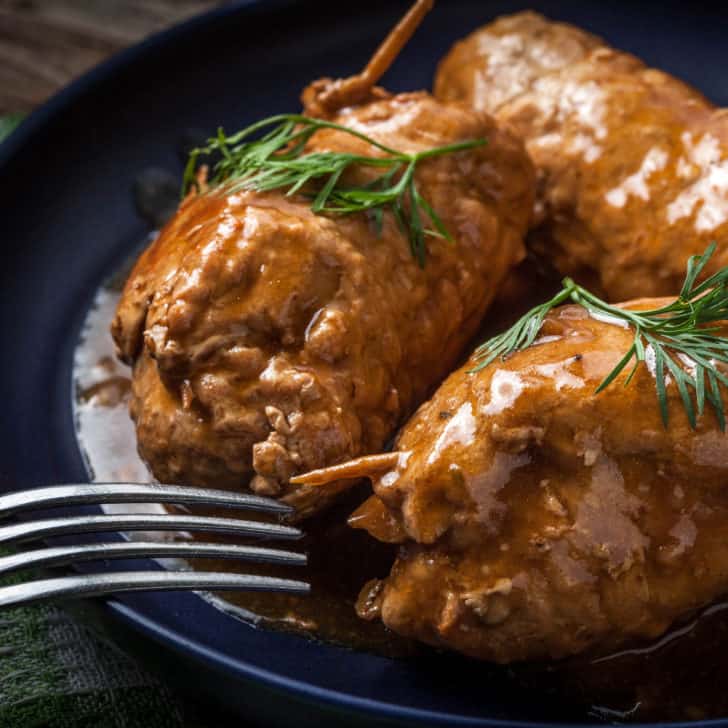
Growing up in Stuttgart, we regularly enjoyed family dinners with my Oma and Opa. My Oma was famous for her Kasseler, Kartoffelpuffer, Sauerbraten and her Rouladen. When a meal included gravy she always knew to make extra when we came over because I would heap copious amounts of it over my meat, potatoes, Knödel, Rotkohl, Sauerkraut, you name it. (I still do.) For me the gravy was one of the primary highlights of the meal. Rouladen is one of my all-time favorite German dishes and its accompanying gravy is arguably the king of all gravies. Today I’m sharing my homemade Rouladen recipe with you and I’m confident you’re going to love it as much as we do!
What Are Rouladen?
Rouladen is a traditional German dish featuring long, thin strips of meat slathered with mustard and filled with bacon, onions, and pickles. The filling is enclosed by rolling up the meat strips and the roulades are then browned and slow-simmered in a rich gravy.
Rouladen are enjoyed throughout the year in Germany but are often associated with Sunday dinners and special occasions like Christmas Eve.
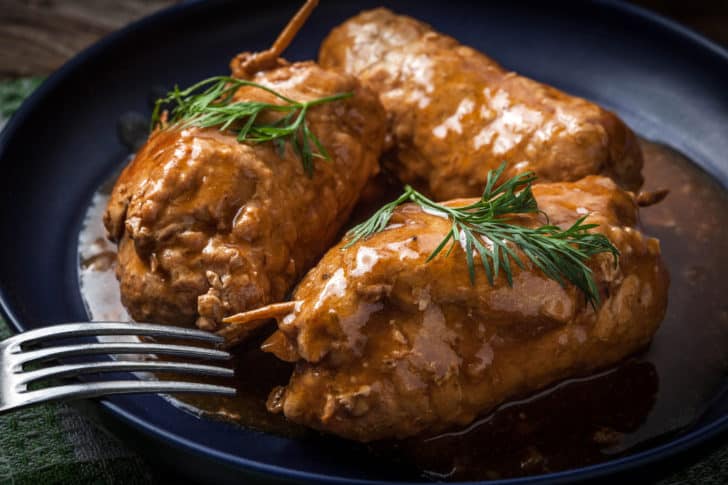
Can Rouladen Be Made Ahead Of Time?
You can save time by assembling the rouladen in advance and chilling them until you’re ready to cook them. They are also good reheated.
How Large Should the Slices of Beef Be?
They need to be large enough to stuff and roll up, at least 4×6 inches in size and about 1/4 inch thick. This recipe makes 2 rouladen per person. Alternatively you can make larger rouladen and serve one large rouladen per person.
Flour or Cornstarch to Thicken the Gravy?
You can use either. Cornstarch will make a more translucent gravy and flour will make a slightly opaque gravy. It just comes down to personal preference and/or allergies.
What Do I Serve With Rouladen?
Traditionally, Rouladen are served with Rotkohl and boiled potatoes or Knödel – either Semmelknödel (bread dumplings) or Kartoffelklöße (potato dumplings). Instead of potatoes or Knödel, they are also commonly served with Spätzle.
Get our recipe or Authentic German Rotkohl
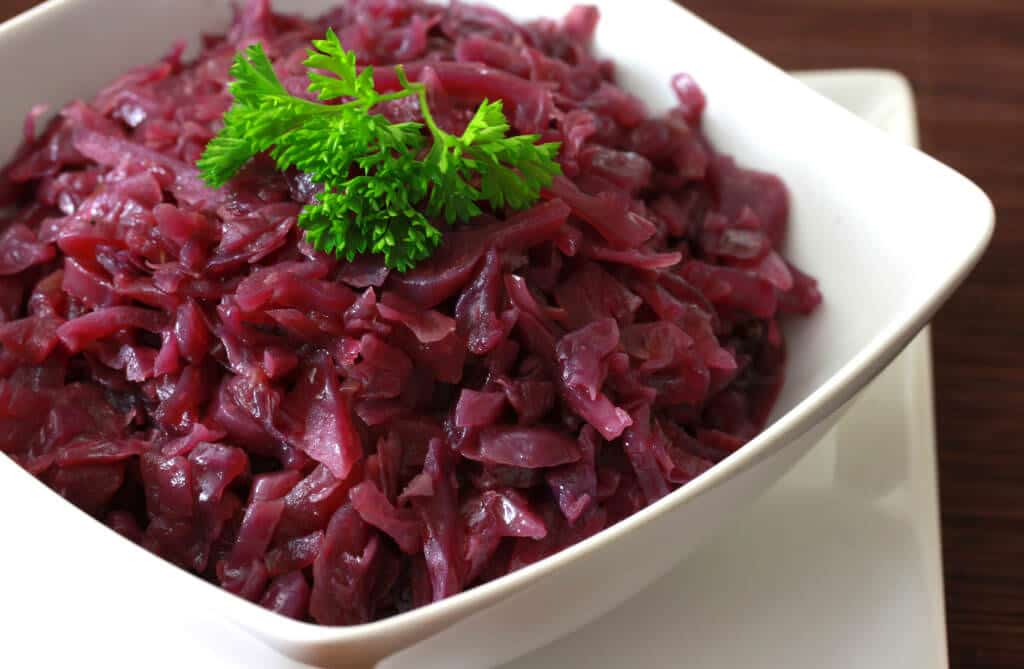
Get our recipe for Authentic German Semmelknödel (Bread Dumplings)
Get our recipe for Authentic German Spätzle
Authentic Rouladen Recipe
Rouladen aren’t hard to make, but they do take time. You can shave off some time on the day of your meal by assembling the rouladen ahead of time and chilling them until you’re ready to cook them.
Rouladen are made by spreading some German mustard on thinly cut slices of beef, adding bacon, sliced German pickles and chopped onions. Sprinkle with some salt and pepper and roll them up, securing the rolls with toothpicks or cooking twine. Next you generously fry the rouladen in oil until they’re nicely browned on all sides. They’re then removed and set aside so you can saute the onions and vegetables for the gravy. Add the liquids and spices to the cooked veggies and nestle the rouladen in this mixture to simmer on low until the meat is fork tender. The rouladen are removed, the sauce is poured through a strainer, and the resulting gravy is returned to the pot and thickened. The rouladen are returned to the gravy, heated through and served with Rotkohl and boiled potatoes, Knödel, or Spätzle.
Below we’ve provided step-by-step pictured instructions to ensure your success!
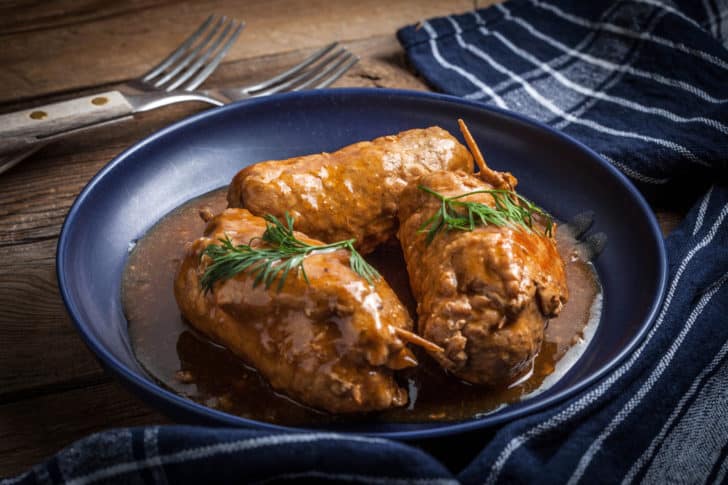
© Arkadiusz Fajer | Dreamstime
Let’s get started!
Lay the beef slices out on a work surface. Spread each beef slices with about 2 teaspoons of German mustard and sprinkle with a little salt and freshly ground black pepper.
Place a strip of bacon on each beef slice so it’s running the same length as the beef. Place the sliced German pickles and chopped onions on each beef slice. 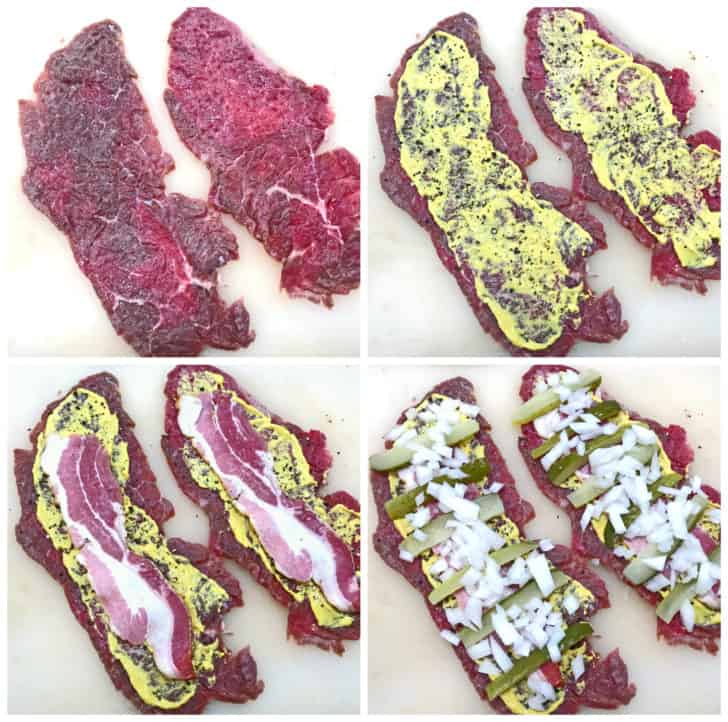
Roll up the beef slices, tucking in the sides as best you can and securing the beef rolls with toothpicks or cooking twine.
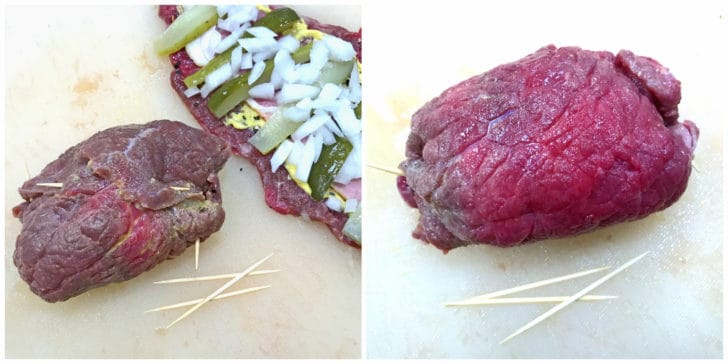
Heat the butter and oil in a heavy Dutch oven or pot (make sure it’s oven-safe if baking in the oven) and generously brown the rouladen on all sides. Browning them well will ensure a rich and flavorful gravy. Set the rouladen aside on a plate.
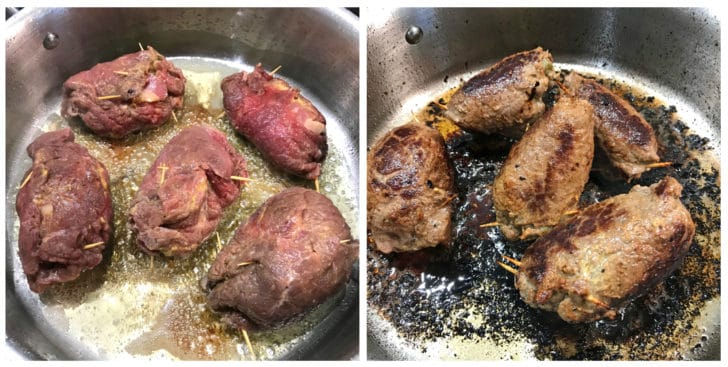
*Do not remove the browned bits in the bottom of the pan, it’s key to the most flavorful gravy!
Add the onions to the pot and a little more butter or oil if needed. Cook the onions until softened and translucent, about 5 minutes. Add the garlic and cook for another minute. Add the leek, carrots and celery and cook for another 5 minutes. Pour in the red wine, bring to a rapid boil for one minute, reduce the heat to medium and simmer for 2-3 more minutes.
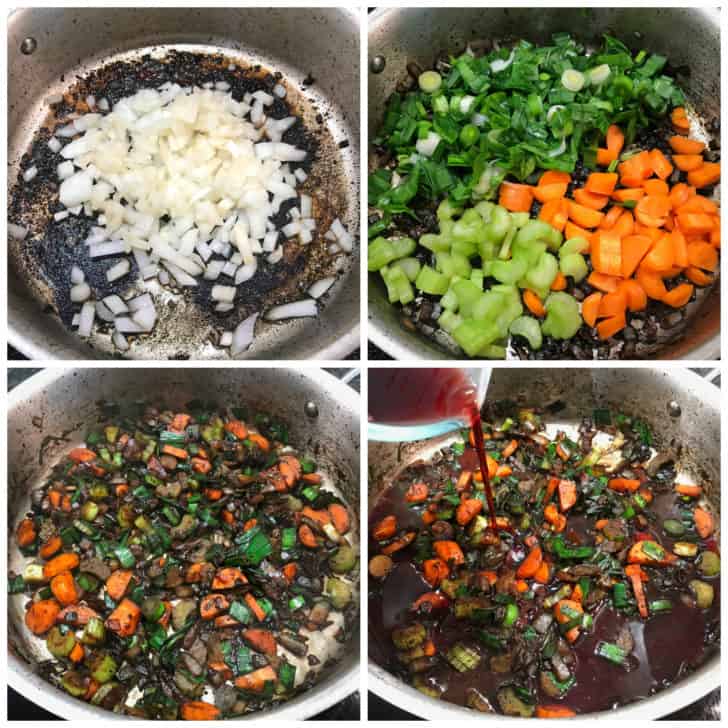
Add the beef broth, tomato paste, bay leaf, salt and pepper.
Nestle the rouladen in the pot.
Oven or Stovetop: You can cook the rouladen, covered, on the stovetop on low for about 90 minutes or until fork tender but for the most even cooking we recommend transferring the pot (make sure it’s oven-safe) to the oven preheated to 325 F and cook it there for about 90 minutes or until fork tender.
To Make the Rouladen Gravy:
When the beef is fork tender, remove the rouladen from the pot and set aside. Pour the liquid and vegetables through a strainer and reserve the liquid. (You can set the veggies aside for another purpose, they are yummy. Or, as some of our readers have mentioned, you can puree the veggies in the blender and then return them to the gravy.)
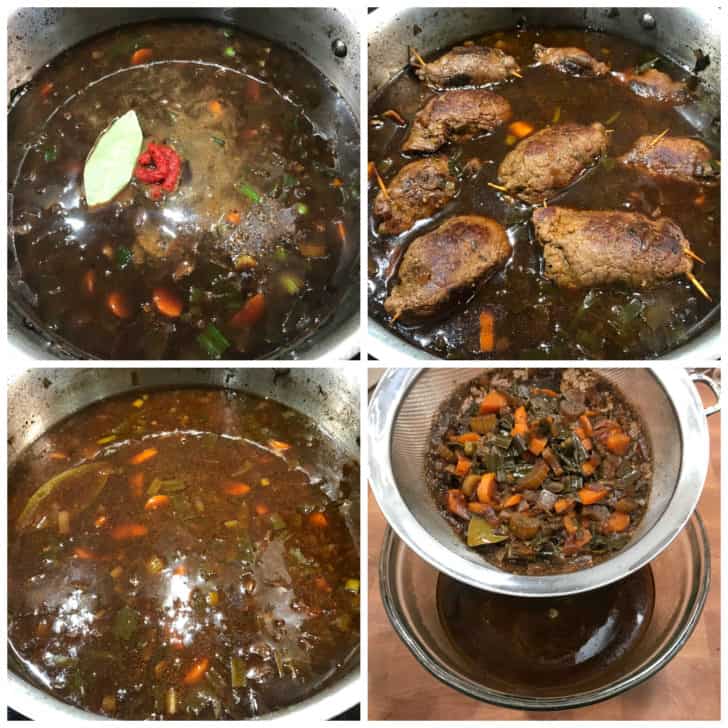
Return the strained liquid back to the pot and bring to a simmer. Thicken the gravy either with either a cornstarch slurry (for a clear/translucent gravy) or flour slurry (for an opaque gravy). For a creamy gravy you can also add a few tablespoons of heavy cream at this point. Simmer, whisking constantly, until the gravy is thickened.
Add the chilled butter, whisking constantly, until the butter is melted and incorporated. Add salt, pepper and mustard to taste. Note: If you’d like creamy gravy you can stir in some heavy cream at this point.
Carefully remove the toothpicks or cooking twine from the rouladen and return them to the gravy and heat through.
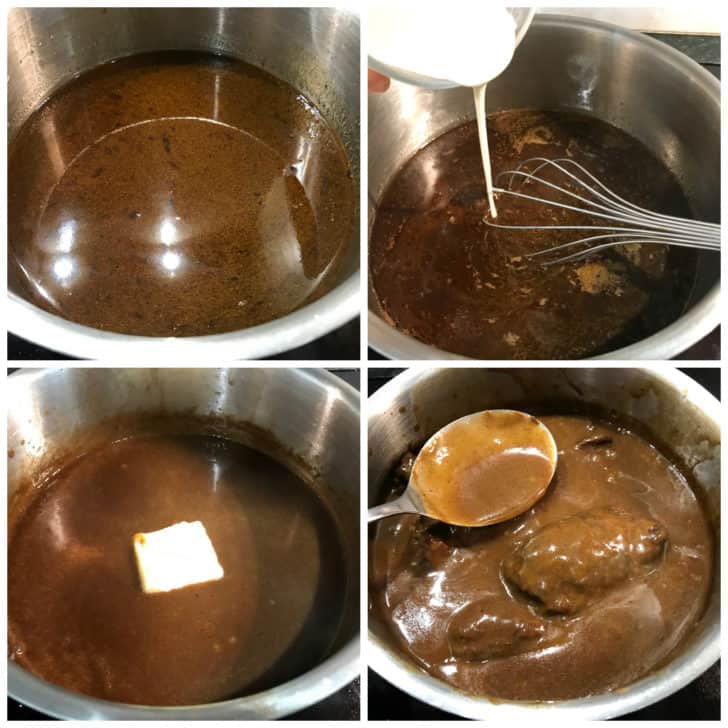
Serve the Rouladen with Rotkohl and either boiled potatoes, Semmelknödel (bread dumplings) or Kartoffelklöße (potato dumplings) or Spätzle.
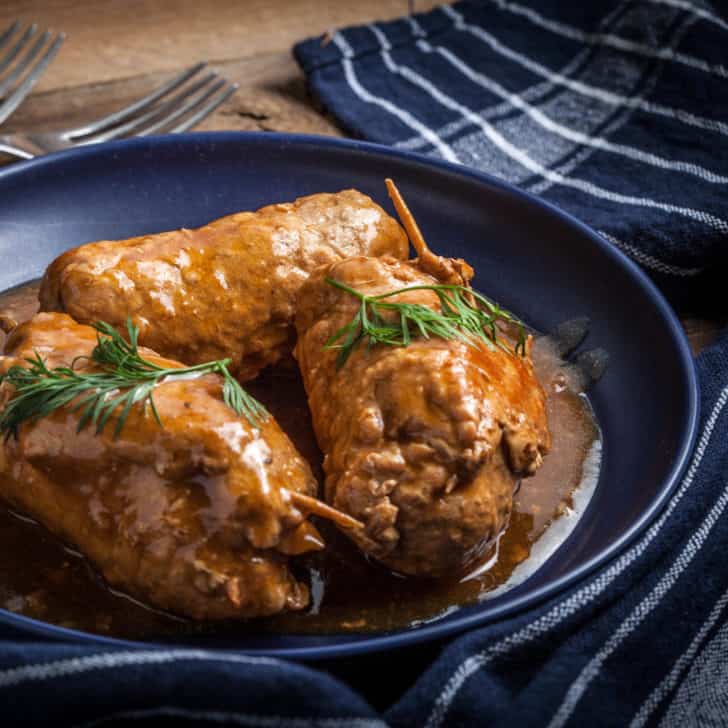
For more authentic German dishes, be sure to also try our:
- Sauerbraten
- Käsespätzle (Cheese Spaetzle)
- Swabian Potato Salad
- Senfbraten (Roast Pork with Mustard Gravy)
- Schnitzel
- Jägerschnitzel
- Maultaschen
- German Potato Soup
- Frikadellen
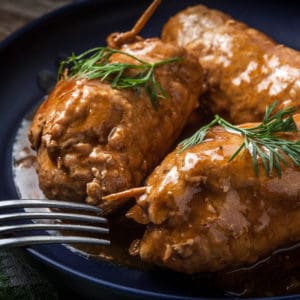
Authentic German Rouladen
Ingredients
- For the Rouladen:
- 8 slices top round beef, about 4x6 inches in size and 1/4 inch thick (*see note) (ask your butcher), gently pound the slices with a meat mallet until they're a little thinner than 1/4 inch (be careful not to pound holes into them)
- 1/3 cup German yellow mustard
- 8 slices bacon
- 8 medium German pickles , sliced lengthwise
- 1 medium yellow onion , chopped
- salt and freshly ground black pepper
- For the Gravy:
- 1 tablespoon butter
- 1 tablespoon cooking oil
- 1 medium yellow onion , chopped
- 1 clove garlic , minced
- 1 small leek , chopped, rinsed and drained in colander
- 1 large carrot , chopped
- 1 large celery stalk , chopped
- 1 cup dry red wine
- 2 cups strong beef broth
- 1 tablespoon tomato paste
- 1 bay leaf
- 1 teaspoon sugar
- 1/2 teaspoon salt
- 1/4 teaspoon freshly ground black pepper
- 4 tablespoons chilled butter
- cornstarch or flour dissolved in a little water for thickening (depending on how much gravy liquid there is you'll need about 1-2 tablespoons of cornstarch dissolved in 2-3 tablespoons of water or 2-3 tablespoons flour dissolved in 1/4 - 1/3 cup water)
Instructions
- Lay the beef slices out on a work surface. Spread each beef slices with about 2 teaspoons of mustard and sprinkle with a little salt and freshly ground black pepper. Place a strip of bacon on each beef slice so it's running the same length as the beef. Place the sliced German pickles and chopped onions on each beef slice. Roll up the beef slices, tucking in the sides as best you can and securing the beef rolls with toothpicks or cooking twine.
- Heat the butter and oil in a heavy Dutch oven or pot (make sure it's oven-safe if baking in the oven) and generously brown the rouladen on all sides. Browning them well will ensure a rich and flavorful gravy. Set the rouladen aside on a plate.
- *Do not remove the browned bits in the bottom of the pan (important for a flavorful gravy): Add the onions to the pot and a little more butter or oil if needed. Cook the onions until softened and translucent, about 5 minutes. Add the garlic and cook for another minute. Add the leek, carrots and celery and cook for another 5 minutes. Pour in the red wine, bring to a rapid boil for one minute, reduce the heat to medium and simmer for 2-3 more minutes. Add the beef broth, tomato paste, bay leaf, sugar, salt and pepper.
- Nestle the beef rouladen in the pot. Oven or Stovetop: You can cook the rouladen, covered, on the stovetop on low for about 90 minutes or until fork tender, but for the most even cooking we recommend transferring the pot (make sure it's oven-safe) to the oven preheated to 325 F and cook it there for about 90 minutes or until fork tender.
- To Make the Rouladen Gravy:When the beef is fork tender, remove the rouladen from the pot and set aside. Pour the liquid and vegetables through a strainer and reserve the liquid. (You can eat the veggies on the side or puree them in the blender and then return them to the gravy.) Return the strained liquid back to the pot and bring to a simmer. Thicken the gravy either with either a cornstarch slurry (for a clear/translucent gravy) or flour slurry (for an opaque gravy). For a creamy gravy you can also add a few tablespoons of heavy cream at this point. Simmer, whisking constantly, until the gravy is thickened.Add the chilled butter, whisking constantly, until the butter is melted and incorporated. Add salt, pepper and mustard to taste. Note: If you prefer a creamy gravy you can stir in some heavy cream.Carefully remove the toothpicks or cooking twine from the rouladen and return them to the gravy and heat through.
- Serve the rouladen and gravy with Homemade Rotkohl and either Homemade Spätzle, Homemade SemmelKnödel (or Kartoffelknödel) or boiled potatoes.
Notes
- This recipe makes 2 rouladen per person. Alternatively you can make larger rouladen for one large rouladen per person.
Nutrition

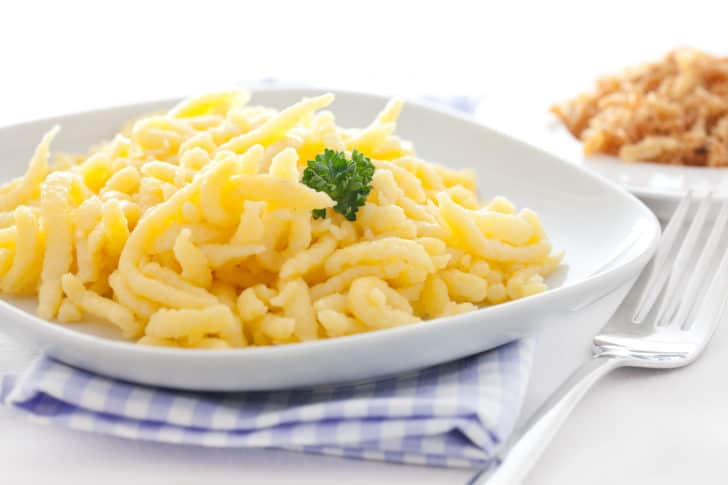
Dottie Hashizumi says
I am from München and your recipe is almost identical to how my family made ours. Only difference is we dice our bacon finely instead of one long slice. And you are so very right in saying German pickles & mustard are different than U.S, But like meatloaf, every family has their own “special” touches.
Gloria Heister says
Are dill pickles the same as German pickles?
Kimberly Killebrew says
Hi Gloria, no they are not. There really is no equivalent to German pickles here in the U.S.
martin schmidt says
This will be my first effort at fabricating our rouladen. The local German butchers have always made them, but I just called and they said ‘Nein’. So rouladen search and here I am. After almost 60 years of Oma and Mom’s rouladen here comes the big adventure. I’ve concurred my own Rotkohl and Kartofflesalat, so rouladen and spatelze are the last items to concur for the Christmas Eve family meal.
I’ll report back as to how amazing it is ( was ).
Cheers
Cat Erin says
I used to eat this in Schwartzwald, and it was a treat. When my local grocery store was selling sliced rouladen I bought some and made this recipe. Rookie mistake was trying to brown all of the Rouladen at once in the Dutch oven. The toothpicks caught on the other rouladens and it was hard to brown them easily. It’s better to brown them two or three at a time or else you don’t get the browned bits for the gravy. Instead of celery I used fennel stalks. Because food is so expensive, the precious vegetables were puréed and added back into the gravy. Delicious!
Kimberly Killebrew says
Thank you, Cat, I’m so glad you enjoyed them! :)
Darren says
Good recipe. I saved one and let it sit in the refrigerator overnight. It was even better. Worth the effort! Thank you!
Kimberly Killebrew says
Fantastic, Darren, thank you!
Darrington says
So yammy!
Ramona Holmes says
Very similar to my Oma’s recipe, for a richer gravy try adding either sour cream or plain Greek yogurt to the gravy. Ensure you don’t add the cold sour cream/yogurt directly to warm gravy or it will curdle. Put some sour cream on a glass and slowly stir in a few teaspoons of warm gravy to warm it up before adding to the gravy. So yummy
Lori says
I would love to make this but I am intimidated by exactly what cut of beef to buy and how to get it the right shape and size. Any suggestions?
Kimberly Killebrew says
Hi Lori, I recommend using top round and you’ll need to ask the butcher to cut it for you. Specify about 4×6 inches in size and 1/4 inch thick.
Kate says
I’m concerned about the bacon. Love crispy bacon, but not limp bacon. Am I right in assuming this bacon just kind of melts into the sauce?
Kimberly Killebrew says
Hi Kate, it doesn’t melt completely, no. If you’re concerned about the texture you can use smoked ham instead.
Anonymous says
I highly recommend it as written, even with that fear. A german friend made it for me years ago. I thought…”I don’t think so” on the bacon. It’s one of my favorite go-to recipes…ever. Make it once, and after that…it’s a breeze. It’s fun to serve to people who have never heard of it. At first, they may have our same thoughts. Until they taste it.
Anonymous says
Brown the beef at what heat level?
Kimberly Killebrew says
Hi, heat your pan on medium-high and wait until it’s very hot before adding the meat. Be sure not to overcrowd the pan or the meat will just steam instead of brown. Turn up the heat even higher if needed.
Flughafen says
A much less expensive but absolutely just as delicious as the last time I made Osso Buco. This is GREAT! Thanks for the adventure.
Kimberly Killebrew says
Thank you so much, Flughafen! :)
Lina says
Great reminds me of my Omas Rouladen, I do little twist to this recipe but this is the best and closest one ! Thank you so much !
Kimberly Killebrew says
Wonderful, Lina, thank you so much!
Regina says
I am a fellow Swabian, grew up in a smaller village between Stuttgart and Heilbronn, and that is exactly how I have made Rouladen all my life, nearly 50 years of cooking.
We always made Kartoffelknoedel (potato dumplings) with it on rare occassions my personal favorite Hefekloesse (yeast dumplings), they soak up the beautiful gravy. Which is my favorite part as well.
Amy Greener says
This is THE rouladen recipe that truly comes closest to my dear German friend Lore’s.
And hers was spectacular. I found Milanesa-cut beef (1/4 inch thick top round slices) at my local Walmart and thought I’d try her recipe. But I couldn’t find it, so I gave yours a try as it looked similar. Wow, what flavor. I was concerned because my dutch oven was almost black on the bottom and up the sides after I browned the rouladen. I finely chopped the veggies (minus the leek) and after adding the wine and beef stock, crossed my fingers that the gravy would not have a burnt flavor. To my surprise, it didn’t and was exceptionally good. 90 minutes at 325 degrees produced perfectly fork-tender bites. Lore would be proud. Thank you for one of those rare, first-time-trying-it recipes that actually comes out exceptionally good!
Kimberly Killebrew says
I’m so thrilled to hear that and appreciate the feedback, Amy, thank you!
Gail Buganski says
I made this recipe as it was very similar to my late mother in laws. I did not use the pickles tho. I read it was used to celebrate something. We lost our power due to a storm and I made it ahead and wanted it to eat. So I overrode the electronic igniter on my stove and doctored the gravy. It was so good! Thank you for sharing your recipe, we really appreciate it!!
Kimberly Killebrew says
Thank you, Gail, I’m so glad you enjoyed it and were able to make it in spite of the obstacles!